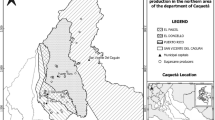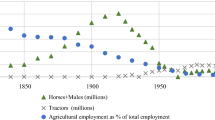Abstract
Vision 2030, Kenya’s development blueprint for the period 2008–2030, envisions transforming the country into middle-income status where citizens enjoy a high quality of life. The blueprint has three pillars: economic, political and social. The thread that binds the three pillars is the natural environment, which supplies both renewable and non-renewable resources. Unfortunately, development in the other sectors may easily compromise the conditions of the natural environment and put the supply of clean water, food and fiber in jeopardy. For example, processing of agricultural products may increase gains from agriculture and lead to rapid expansion of the sector. If this is not carefully done, it may be characterized by wastage of resources, cutting down of forests to provide fuel and more land for cultivation, disposal of raw wastes into water bodies and over-exploitation of the soils. Using the example of small-scale tea processors in the country, this study sought to understand the environmental efficiency of the small-scale agro-processors. Small-scale tea processors were chosen because they have been implementing environmental efficiency-enhancing techniques in their production, yet no study had endeavored to test whether their initiatives were yielding positive results. The study adopted the innovative inverse data envelopment analysis approach on panel data to generate environmental efficiency scores, in the first step. In the second step, it analyzed the predictors of environmental efficiency using Tobit regression. Overall, the results showed that small-scale tea processors in Kenya were still environmentally inefficient, recording a mean efficiency index of only 49%, despite previous initiatives to improve efficiency. Thus, the processors could reduce 51% of the environmentally detrimental inputs without compromising output. Environmental inefficiency could be attributed to pursuit for higher profits and higher cost of investible funds. This shows that investment in environmental conservation is expensive and eats into the profits of the processors. Therefore, the small-scale processors may lack the incentives, in the short term, to invest in environment-friendly technologies. This may be compounded by the high cost of finance to be invested in such initiatives. Policy implication is that government should intervene in terms of tax concessions for firms that invest in environmental conservation, subsidies on technologies that guarantee environmental efficiency and access to cheaper funds for purchase and maintenance of environment-friendly technologies.



Similar content being viewed by others
References
Azapagic, A., Bore, J., Cheserek, B., Kamunya, S., & Elbehri, A. (2015). Global warming potential of production and consumption of Kenya tea. Journal of Cleaner Production,112(5), 4031–4040.
Basnayake, K., & Gunaratne, P. (2002). Estimation of technical efficiency and its determinants in the tea small holding sector in the mid country wet zone of Sri Lanka. Srilankan Journal of Agricultural Economics,4(1), 15.
Chang, Y. T. (2013). Environmental efficiency of ports: A data envelopment analysis approach. Maritime Policy & Management,40(5), 467–478. https://doi.org/10.1080/03088839.2013.797119.
Chang, Y. T., Zhang, N., Danao, D., & Zhang, N. (2013). Environmental efficiency analysis of transportation system in China: A non-radial DEA approach. Energy Policy,58(2013), 277–283. https://doi.org/10.1016/j.enpol.2013.03.011.
Charnes, A., Cooper, W. W., & Rhodes, E. (1978). Measuring the efficiency of decision making units. European Journal of Operational Research,2, 429–444.
Chen, J., Song, M., & Xu, L. (2015). Evaluation of environmental efficiency in China using data envelopment analysis. Ecological Indicators,52, 577–583. https://doi.org/10.1016/j.ecolind.2014.05.008.
Cooper, W. W. (1999). Operational research/management science—Where it’s been—Where it should be going. Journal of the Operational Research Society,50, 3–11.
Cooper, W. W., Seiford, L. M., & Tone, K. (2000). Data envelopment analysis, a comprehensive test with models, applications, references and DEA-solver software. Boston: Kluwer Academic Publishers.
Dunk, A. S. (2002). Product quality, environmental accounting and quality performance. Accounting, Auditing & Accountability Journal,15(5), 719–732. https://doi.org/10.1108/09513570210448975.
Friedman, M., (1970). The social responsibility of business is to increase its profits. The New York Times Magazine, 173–178.
Hong, N. B., & Yabe, M. (2015a). Resource use efficiency of tea production in Vietnam: Using translog SFA model. Journal of Agricultural Science,7(9), 160–172. https://doi.org/10.5539/jas.v7n9p160.
Hong, N. B., & Yabe, M. (2015b). Technical efficiency analysis of tea production in the northern mountainous region of Vietnam. Global Journal of Science Frontier Research,15(1), 30–42.
Huang, Y., & Kao, J. (2012). Method for assessing corporate environmental performance. Inefficiency countervailed DEA (IC-DEA). The Journal of the Operational Research Society,63(4), 470–477. https://doi.org/10.1057/jors.201.
Huang, Y., Wong, Y., & Yang, M. (2014). Proactive environmental management and performance. Management Research Review,37(3), 210–240. https://doi.org/10.1108/MRR-09-2012-0196.
Kamande, M. (2010). Technical and environmental efficiency of Kenya’s manufacturing sector: A stochastic frontier analysis. In The thirteen annual conference on Global Economic Analysis, United Nations Conference Centre, Bangkok, Thailand 2010, p. 33.
KNBS. (2015). Economic survey. Nairobi: Government of Kenya.
Long, X., Zhao, X., & Cheng, F. (2015). The comparison analysis of total factor productivity and eco-efficiency in China’s cement manufactures. Energy Policy,81, 61–66. https://doi.org/10.1016/j.enpol.2015.02.012.
Maity, S. (2017). Agris on-line papers in economics and informatics reform raises efficiency of tea estates in India. Agris On-Line Papers in Economics and Informatics,IX(2), 101–116. https://doi.org/10.7160/aol.2017.090209.
Owuor, P. O., Kavoi, M. M., Wachira, F. N., & Ogola, S. O. (2007). Sustainability of smallholder tea growing in Kenya. International Journal of Tea Science,6(1), 1–23.
Reinhard, S., Lovell, C. K., & Thijssen, G. J. (2000). Environmental efficiency with multiple environmentally detrimental variables; estimated with SFA and DEA. European Journal of Operational Research,121(2), 287–303.
Sayi, J. B. (2014). Determinants of energy efficiency in black tea processing factories: A case of Kenya Tea Development Agency. Unpublished Thesis, University of Nairobi.
Severo, E. A., de Guimarães, J. C. F., & Dorion, E. C. H. (2017). Cleaner production and environmental management as sustainable product innovation antecedents: A survey in Brazilian industries. Journal of Cleaner Production,142, 87–97. https://doi.org/10.1016/j.jclepro.2016.06.090.
Song, M., An, Q., Zhang, W., Wang, Z., & Wu, J. (2012). Environmental efficiency evaluation based on data envelopment analysis: A review. Renewable and Sustainable Energy Reviews,16(7), 4465–4469.
Song, M., Wang, S., & Liu, W. (2014). A two-stage DEA approach for environmental efficiency measurement. Environmental Monitoring and Assessment,186(5), 3041–3051. https://doi.org/10.1007/s10661-013-3599-z.
Taulo, J. L., & Sebitosi, A. B. (2016). Material and energy flow analysis of the Malawian tea industry. Renewable and Sustainable Energy Reviews,56, 1337–1350. https://doi.org/10.1016/j.rser.2015.11.072.
Tea Board of Kenya. (2010). Opening emerging markets for Kenyan Tea, Nairobi.
Tian, D., Zhao, F., Mu, W., Kanianska, R., & Feng, J. (2016). Environmental efficiency of Chinese open-field grape production: An evaluation using data envelopment analysis and spatial autocorrelation. Sustainability (Switzerland),8(12), 13. https://doi.org/10.3390/su8121246.
van der Wal, S. (2008). Sustainability issues in the tea sector—A comparative analysis of six leading production countries (pp. 1–110). Amsterdam: SOMO Publication.
Worrell, E., Allwood, J., & Gutowski, T. (2016). The role of material efficiency in environmental stewardship. Annual Review of Environment and Resources,41(1), 575–598. https://doi.org/10.1146/annurev-environ-110615-085737.
Zhang, F., Fang, H., Wu, J., & Ward, D. (2016). Environmental efficiency analysis of listed cement enterprises in China. Sustainability (Switzerland),8(5), 1–19. https://doi.org/10.3390/su8050453.
Author information
Authors and Affiliations
Corresponding author
Additional information
Publisher's Note
Springer Nature remains neutral with regard to jurisdictional claims in published maps and institutional affiliations.
Rights and permissions
About this article
Cite this article
Gatimbu, K.K., Ogada, M.J. & Budambula, N.L.M. Environmental efficiency of small-scale tea processors in Kenya: an inverse data envelopment analysis (DEA) approach. Environ Dev Sustain 22, 3333–3345 (2020). https://doi.org/10.1007/s10668-019-00348-x
Received:
Accepted:
Published:
Issue Date:
DOI: https://doi.org/10.1007/s10668-019-00348-x




